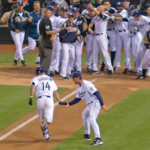Preventing Pitching Injuries (Tommy John): The Coach’s Role
There are few hotter topics in the baseball world than how to handle pitchers and keep them injury free. This topic was pushed in to the national forefront last season when the Washington Nationals shut down Stephen Strasberg in early September and potentially lessened their chances of reaching and winning the World Series. This season, MLB has seen a rash of torn UCLs (the injury that results in Tommy John Surgery) and is desperately looking for answers.
Everyone has an opinion on how to best handle pitchers and why they seem to breaking down more than ever. Some people say kids are pitching too much, some say they don't pitch enough. Some say it's because they throw off a mound too much, some say it's because they don't throw off a mound enough. It's weighted baseballs, it's travel baseball, it's mechanical inefficiencies, it's long toss, it's not enough long toss, it's ...

My guess is that more than just one factor is leading to the increase of Tommy John surgeries, and in many cases, the damage has probably been done long before the pitcher reaches MLB. One possible solution to this is educating amateur coaches, players, and parents to the cumulative danger of throwing too much, and throwing when fatigued.
An example of how coaches can "get caught up in the moment" occurred in Louisiana High School baseball this past week where two pitchers threw a combined 25 innings and combined for 347 pitches. Read the story here: http://goo.gl/qhEqSI
In spite of having had a significant shoulder surgery myself, I am not a doctor, nor to I pretend to know enough to about the anatomy of the shoulder and elbow to add any significant medical information to a discussion about pitcher safety (I also did not stay at a Holiday Inn Express last night). I do believe that a little research along with an athlete centered coaching philosophy can give you the assurance that you are doing as much as you can to keep your pitchers healthy.
Here are a few of the things we know about pitching injuries:
1.) 1 out of 20 youth pitchers will have a major throwing related injury
2.) Pitchers who throw more than 100 innings in a year are 3.5 time more likely (may be as high as 10 times more likely) to sustain a major throwing injury.
3.) Pitchers who also play catcher may have a higher risk of major throwing injury
4.) Pitchers who participate in a longer season and play in more games have a higher risk of injuries
5.) Pitchers who participate in more showcases have a higher risk of injury
6.) Pitchers who throw with more velocity have a higher risk of injury
7.) There appears to be no significant relationship between injury risk and private pitching coaches, exercise program, frequency of relief appearances, or ages at which types of pitches are thrown (I have read conflicting articles on this last one).
Sign Up For More Great Content Here
Some of the things I have been reading, specifically the one about “no significant relationship and the age at which pitches are thrown” are conflicting. I am planning on doing more research on this, but my personal belief is that kids simply do not have enough arm strength at a young age make a curveball break without throwing improperly and significantly risking elbow injury. Some of the studies I have read do in fact say that there is a relationship between the age someone starts throwing a curveball and throwing injuries. For the time being I will err on the side of caution and try to discourage kids under the age of 15 from throwing curveballs.
With the plethora of information available, here is a brief overview of what you can do as a coach do to help minimize throwing injuries in your pitchers.
1.) Realize that sometimes things just break - You can be as cautious as possible, put your athlete’s safety first, count every pitch, limit innings, and still, sometimes things just happen. Do not take a single injury to mean that what you are doing isn’t working. If you have been taking the proper precautions keep with what you are doing.
2.) Research - Do as much research as you can on this topic. There are constantly new studies coming out in the medical community about pitcher safety. The decisions you make on how to handle your pitching staff should be based on these, not what you hear on sports talk radio, read on a message board or remember from your youth baseball experience.
3.) Count pitches, count innings, and count days of rest - The American Sports Medicine Institute has published the following recommendations for days of rest based on age and pitches thrown:
ASMI Pitch Count/Recovery Recommendations
AGE Max.Pitches per game Max. Games per week
8-10 52 2
11-12 68 2
13-14 76 2
15-16 91 2
17-18 106 2
Recovery Times - ASMI Guidelines
Age 1 Day Rest 2 Day Rest 3 Day Rest 4 day Rest
8-10 21 34 43 51
11-12 27 35 55 58
13-14 30 36 56 70
15-16 25 38 62 77
17-18 27 45 62 89
4.) Encourage your players to only pitch for one team in a season - With the currently travel baseball scene, it is not uncommon for someone to play for more than one team at a time. Research has shown that pitching for two or more teams is a bad practice as many times proper rest time is not monitored and pitchers are often overused. This can be a particularly difficult thing to do especially if your team is the one a multi-team player decides not to pitch for.
5.) Put the athlete first - Remember that pitcher safety is more important than winning. Everyone’s first temptation is to do anything to they can to win. It may seem like just a few extra pitches, just a few extra innings, or just one game on short rest. Realize that he may not suffer an injury while you are coaching him, but he may suffer one down the road because of those few extra pitches, those few extra innings, or that one game he threw on short rest.
6.) Develop more pitchers than you think you’ll need - If you want to help protect yourself from overusing pitchers, make sure that you have more than enough to get through your season and every tournament you enter. It is much easier to put someone into the game and have confidence in them if you have taken the time to work with them and develop them as a pitcher than if you have never worked with them.
7.) Work pitch counts up slowly - Many coaches are cautious at the very beginning of the season to limit pitch counts, but then just turn their pitchers loose after a start or two. Remember that pitches in a game, and pitches in a bullpen session are different. The pitches in a game are often thrown under much more stress with more intensity. Also a 100 pitch bullpen session is often exactly 100 pitches. A 100 pitch 7 inning outing in a game will also consist of 20-30 warm-up pitches in the bullpen prior to the game and 38 warm up pitches between innings. That pitcher who was up to 100 pitches in their bullpen sessions may have just thrown 168 pitches in their 100 pitch game for a 68% increase in work load.
As with any sport, there are inherent risks to participating in athletics. The risk for being a pitcher is that you may have some sort of an arm injury. The coach’s job should be to minimize this as much as possible by using his pitchers responsibly.
Bibliography
Fleisig, G.S, et. al. (2010), Risk of serious injuries for baseball pitchers: A ten year prospective study. American Journal of Sports Medicine.
Lyman S, Fleisig GS, Andrews JR, Osinski ED (2002). Effect of pitch type, pitch count, and pitching mechanics on risk of elbow and shoulder pain in youth baseball pitchers. The American Journal of Sports Medicine, 30, 463-468.
ASMI position statement on youth pitching. http://www.asmi.org/asmiweb/position_statement.htm, Updated June 2012.
If you enjoyed this article, join our Bronze Coaching Library by clicking here...
More from my site
 CCA Podcast 030: QA3 – Solving one team’s first inning woes
CCA Podcast 030: QA3 – Solving one team’s first inning woes CCA Podcast 253 – The three things that matter for hitters
CCA Podcast 253 – The three things that matter for hitters CCA Podcast 082 – Getting the most out of your catchers in practice
CCA Podcast 082 – Getting the most out of your catchers in practice Mini – 5 ways to make your practices more game like
Mini – 5 ways to make your practices more game like CCA Podcast 0075 – Handling Blowouts
CCA Podcast 0075 – Handling Blowouts CCA Podcast 037 – 5 ways to score more runs in 2016
CCA Podcast 037 – 5 ways to score more runs in 2016
 Posted by Kyle Nelson
Posted by Kyle Nelson- Posted in Pitching
 Feb, 28, 2016
Feb, 28, 2016 3 Comments.
3 Comments.
Elite members login here
Check out what’s New/Hot!
Recognizing, Diagnosing, and Fixing Common Hitting Flaws eCourse The 3 metrics we tested on Blast motion sensors this year Sneak Peek Inside an Elite Q and A The batting practice continuum Elite Member’s area table of contents 50+ “Chaos” hitting drills
5 sample Chaos hitting drills FREE
Mental Skills and Culture Building The hitting pyramid Welcome Elite Member, Trey! Ideas for a pitcher first practice 12 week bat speed improvement plan Make plans this offseason to have your team playing their best baseball at the end of the year” Top 5 hitting drills to translate practice skill to game performanceHow we used Blast Motion sensors with a team in 2019
What to do if your hitters are overmatched Welcome Elite Member, Tommy! Setting your baserunners up for success Welcome Elite Member, Mike! A consulting call with Elite Member Matt FREE Web Clinic: Developing Athletic, Consistent, Extraordinary Infielders
 Coach Kyle Nelson
Coach Kyle Nelson
[…] Our article on reducing the rate of Tommy John – Our research based article on how to safely manage pitchers. This article includes the ASMI pitch charts for rest and pitch maximums. […]
[…] Preventing arm injuries – blog post that gives common sense solutions to decrease the number of arm injuries. […]
[…] Blog post on pitcher safety – This blog post gives you many of the risk factors and common sense actions coaches can take to prevent pitching injuries. […]